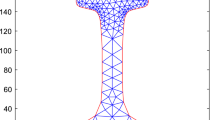Abstract
High-speed rails with determined length and load run for long periods at almost uniform speeds along fixed routes, constituting a new stable and repeatable artificial seismic source. Studies have demonstrated the wide bands and discrete spectra of high-speed rail seismic signals. Exploring the abundant information contained in massive high-speed rail seismic signals has great application value in the safety monitoring of high-speed rail operation and subgrade. However, given the complex environment around the rail network system, field data contain not only high-speed rail seismic waves but also ambient noise and the noise generated by various human activities. The foundation and key to effectively using high-speed rail seismic signals is to extract them from field data. In this paper, we propose an adaptive variational mode decomposition (VMD)-based separation algorithm for high-speed rail seismic signals. The optimization algorithm is introduced to VMD, and sample entropy and energy difference are used to construct the fitness function for the optimal adjustment of the mode number and penalty factor. Furthermore, time–frequency analysis is performed on the extracted high-speed rail signals and field data using the synchrosqueezed wavelet transform (SSWT). After verifying the processing of simulated signals, the proposed method is applied to field data. Results show that the algorithm can effectively extract high-speed rail seismic signals and eliminate other ambient noises, providing a basis for the imaging and inversion of high-speed rail seismic waves.
Similar content being viewed by others
References
Chen, J. G., Xia, H., and Cao, Y. M., 2012, Analysis and prediction on environmental vibration include by elevated rail transit: Engineering Mechanics, 29(06), 285–291.
Sanayei, M., Maurya, P., and Moore, J. A., 2013, Measurement of building foundation and ground-borne vibrations due to surface trains and subways: Engineering Structures, 53, 102–111.
Chen, J. Q., Sun, Y., and Zhang, X. M., 2019, Research of Review and Measurement on Environmental Vibration Influence Induced by High-speed Railway: Industrial Safety and Environmental Protection, 45(03), 73–78.
Cao, J., and Chen, J. B., 2019, Solution of Green function from a moving line source and the radiation energy analysis: A simplified modeling of seismic signal induced by high-speed train: Chinese Journal of Geophysics (in Chinese), 62(06), 2303–2312.
Wang, Z. Y., Li, Y. M., and Bai, W. L., 2020, Numerical modelling of exciting seismic waves for a simplified bridge pier model under high-speed train passenge over the viaduct: Chinese Journal of Geophysics (in Chinese), 63(12), 4473–4484.
Liu, L., Liu, Y. J., Li, T., et al, 2021, Inversion of vehicle-induced signals based on seismic interferometry and recurrent neural networks: Geophysics, 86(03), 37–45.
Wang, Z. Y., Chen, C. P., Bai, W. L., et al, 2022, Analysis of the responses of seismic waves excited by the pile foundations of the viaduct when the high-speed trains passage: Chinese Journal of Geophysics (in Chinese), 65(07), 2622–2635.
Zheng, Y. W., Chen, J. L., 2015, Tests and Analysis of Ground Vibration Caused by High-speed Railways: Special Structures, 32(03), 76–79.
Sheng, X., Jones, C. J. C., and Thompson, D. J., 2004, A theoretical study on the influence of the track on train-induced ground vibration: Journal of Sound and Vibration, 272(3–5), 909–936.
Degrande, G., Schillemans, L., 2001, Free field vibrations during the passage of a Thalys high-speed train at variable speed: Journal of sound and vibration, 247(1), 131–144.
He, Z. X., Cui, W. M., 2007, Ground Vibration Generated by High-Speed Trains along Slab Tracks: China Railway Science, 92(02), 7–11.
Chen, F., Takemiya, H., Huang, M., 2011, Prediction and mitigation analyses of ground vibrations induced by high speed train with 3-dimensional finite element method and substructure method: Journal of Vibration and Control, 17(11), 1703–1720.
Wang, X. K., Chen, J. Y., Chen, W. C., et al., 2019, Sparse modeling of seismic signals produced by high-speed trains: Chinese Journal of Geophysics (in Chinese), 62(06), 2336–2343.
Huang, N. E., Shen, Z., Long, S. R., et al., 1998, The empirical mode decomposition and the Hilbert spectrum for nonlinear and non-stationary time series analysis: Proc Rsoc Lond, 454, 56–78.
Shan, D. S., Li, Q., Huang, Z., 2015, Adaptive decomposition and reconstruction for bridge structural dynamic testing signals: Journal of Vibration and Shock, 34(03), 1–6.
Gilles, J., 2013, Empirical wavelet transform: IEEE Transactions on Signal Processing, 61(16), 3999–4010.
Dragomiretskiy, K., and Zosso, D., 2013, Variational mode decomposition: IEEE transactions on signal processing, 62(3), 531–544.
Abdollahzadeh B, Gharehchopogh F S, Mirjalili S, 2021, African vultures optimization algorithm: A new nature-inspired metaheuristic algorithm for global optimization problems: Computers & Industrial Engineering, 158, 107408–107408.
Zhang, Y. J., 2022, Wavelet Decomposition-Based AVOA-DELM Model for Prediction of Monthly Runoff Time Series and Its Applications: Pearl River, 43(07), 158–164.
Acknowledgments
We thanks the Asymmetric Seismology and Application Research Group. This research project is supported by the “HYXD” national projects A2309002, XJZ2023050044, and XJZ2023070052.
Author information
Authors and Affiliations
Corresponding author
Additional information
This work was supported by project A2309002, XJZ2023050044, and XJZ2023070052.
Lei Yang received his B.S. degree from the Anhui University of Science and Technology, China, in 2021. He is currently pursuing a master’s degree at the College of Information Science and Technology, Beijing University of Chemical Technology, China. His primary research focus is numerical analysis of seismic waves.
Rights and permissions
About this article
Cite this article
Lei, Y., Liu, L., Bai, Wl. et al. Seismic Signal Analysis Based on Adaptive Variational Mode Decomposition for High-speed Rail Seismic Waves. Appl. Geophys. (2023). https://doi.org/10.1007/s11770-023-1034-y
Received:
Revised:
Published:
DOI: https://doi.org/10.1007/s11770-023-1034-y




